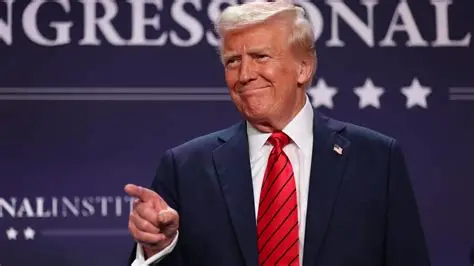President Donald Trump’s administration escalated the government shutdown fight on Wednesday by freezing $26 billion in federal funds earmarked for Democratic-leaning states, striking directly at projects tied to party leaders. The move follows through on Trump’s vow to weaponize the shutdown as leverage against his political rivals while tightening his grip on the nation’s budget.
The freeze covers $18 billion in transit funding for New York, the home state of Senate Majority Leader Chuck Schumer and House Minority Leader Hakeem Jeffries, and $8 billion for clean-energy programs across 16 Democratic-led states including California and Illinois. White House officials made no effort to disguise the political nature of the cuts, underscoring Trump’s intention to punish opponents during the fiscal standoff.
Vice President JD Vance, speaking at a White House briefing, warned that further steps were under consideration, including a purge of federal workers if the shutdown drags beyond a few days. He said layoffs could extend beyond the 300,000 government employees already set to lose their jobs by December. Past shutdowns have not resulted in permanent staff reductions, but the administration has signaled it will break with precedent.
The shutdown, the 15th since 1981, has already suspended a wide array of activities across government. Scientific research has been halted, financial oversight weakened, and cleanup efforts at hazardous environmental sites frozen. Roughly 750,000 federal workers were told to stay home, while others such as members of the military and border agents are being forced to work without pay.
Even services honoring the nation’s veterans are affected. The Department of Veterans Affairs said it would maintain burials at national cemeteries but could not provide new headstones or groundskeeping, leaving final resting places unkept. For families already struggling, the announcement deepened the emotional weight of the standoff.
Senators tried again to restore funding but failed. A Republican plan to extend government operations until late November fell short, as did a Democratic measure that tied spending to expanded health benefits. With Republicans holding a 53-47 Senate majority, they still require at least seven Democrats to reach the 60 votes needed to advance a funding bill.
The dispute revolves around $1.7 trillion to cover annual agency operations, representing about one-quarter of federal spending. The remainder of the $7 trillion budget is consumed by entitlement programs and interest payments on the ballooning national debt, which has now climbed to $37.5 trillion.
Amid failed votes, small groups of senators huddled on the chamber floor to discuss possible compromises. Virginia Democrat Tim Kaine, whose constituents include thousands of federal workers around Washington, said he wanted assurances Republicans would honor any future agreements. He acknowledged the complexity of hammering out a deal but stressed the need for credibility between parties.
Democrats are demanding guarantees that Trump will not disregard appropriations bills once signed into law, a pattern he has followed since returning to office. Lawmakers fear that even successful negotiations could be undone by unilateral decisions from the White House.
The blame game is intensifying as the shutdown grinds on. Democrats argue Republicans are responsible since they control both the White House and Senate. Republicans counter that Democrats are bowing to partisan pressures to oppose Trump, even though they have historically supported spending measures under past administrations.
Republican leaders also revived claims that the Democratic plan would extend health benefits to undocumented immigrants. The nonpartisan Congressional Budget Office contradicted that assertion, noting the bill would only restore coverage for categories of immigrants legally present in the United States, such as asylum seekers and individuals on work visas.
Tensions deepened after several federal agencies posted messages on their websites attributing the shutdown to the “radical left.” Critics say the notices may violate the Hatch Act, a law designed to keep government functions insulated from political messaging. The law’s boundaries have been tested before, but using agency communications to push partisan blame could spark formal investigations.
The political brinkmanship has reignited memories of the longest shutdown in US history, which spanned 35 days during Trump’s first term. That standoff ended when air travel disruptions, triggered by sick-outs among unpaid air traffic controllers, forced the White House to relent. Some lawmakers fear that history could repeat itself if disruption spreads to critical infrastructure.
Beyond the immediate effects, the funding freeze highlights Trump’s willingness to exploit the machinery of government in pursuit of political advantage. By cutting projects in Democratic strongholds, he is signaling that states controlled by his rivals may face direct consequences during budget battles.
As pressure mounts on Congress to break the impasse, both parties are maneuvering for advantage in the run-up to the 2026 midterm elections. With control of Congress at stake, the shutdown has become not just a fight over funding but a test of which side can convince Americans that it is standing up for their interests.
For now, the stalemate leaves hundreds of thousands of workers in limbo, vital projects on hold, and the nation’s political divisions deeper than ever. Whether Trump’s hardline strategy will deliver concessions or spark backlash remains uncertain, but the immediate impact on American lives is already being felt in communities from coast to coast.



